The 37-year-long rolling resto of my BMW 3.0CSi
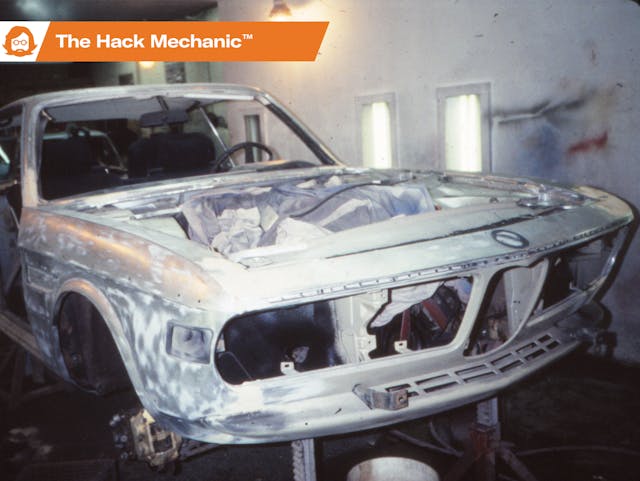
If my Hack Mechanic worldview is about anything, it’s about trying to thread the needle between not craving what you can never have while also being the person with the Cheshire-cat smile while driving the less-than-perfect car you could actually afford. My 37-year-long ownership of my 1973 BMW 3.0CSi is the physical manifestation of all this. Recently, some long-lost photographs of the car came to light that show how, through creativity and dumb luck, I pulled off what on paper is barely possible.
The story begins when my not-yet-wife Maire Anne and I were living in Austin, Texas, in the early 1980s. I’d already gone through half a dozen BMW 2002s, which I was very good at finding by driving around and simply looking down people’s driveways. While doing this, I spied the butt of a car I didn’t know existed—the E9 coupe (the BMW 2800CS/3.0CS/CSi sold from 1968–74). I was transfixed. “Screw 2002s,” my internal car muse said. “I want me one of these.” Unfortunately, due to their classic-even-when-new lines, E9s never really depreciated like 2002s; pretty shiny examples cost 10 grand even 40 years ago.
When we returned to Boston in 1984, I kept looking for an E9 I could afford. Of course, the northern winters made this even harder, as even back then, E9 coupes were legendary rust buckets. The E9’s Karmann-built body seemed to have been pre-rusted at the factory (if you learn only one automotive joke, it should be “Karmann invented rust, then licensed the process to the Italians”), and its construction included a trap under the front fenders where dirt would accumulate, stay wet, and rot out the shock towers, fenders, and firewall from the inside, so by the time you saw the perforations at the bottoms of the fenders, you were faced with nosebleed-level bodywork.
But in the summer of ’86, I read a newspaper ad (remember those?) that said: “1973 BMW 3.0CSi hit front partially repaired no rust many new parts $5200.” In those ancient single-landline-phone days, I wound up talking with the owner’s mother. She said the car hadn’t run in over a year, was under a tarp in her driveway, and was a piece of junk she couldn’t imagine anyone would want. I, of course, was excited beyond words.
When I arrived, I slid off the tarp and found, as Mom had promised, one seriously ugly E9 coupe. Unfortunately, no photos exist of the car in its driveway-find state, but an accident had bashed the nose, creased the fenders and bowed the hood, and a previous owner had applied a balm of aluminum, pop rivets, and bondo. The right fender was particularly cringeworthy, as the crease had been jig-sawed, overlapped, riveted, and filled. In addition, the front windshield was smashed, the rear windshield was missing, the bumpers and trim were off, and the interior was out of the car. Oh, and it was dead. “How much does my son want for this thing?” she asked. She nearly choked when I told her. “If it was up to me,” she said, “you could haul it off for 50 bucks.” This was promising.
The seller, it turned out, worked at a BMW dealership, had been accumulating parts to fix the car, then lost interest. Mom opened the garage and showed me a giant box holding a new rear windshield. There were other boxes with interior parts and much of the trim.
I opened the car’s hood and found that the original Bosch D-Jetronic injection had been removed, but in its place was a set of brand-new Weber 32/36s. Unfortunately, a compression test revealed 80 psi in five cylinders and zero in the sixth. I coaxed it out of its year-long slumber and started it, and it ran just long enough to scatter a family of mice living under the hood while fogging the driveway with a James Bond-level of oil smoke.
So, yeah, the car was a basket case. However, it did appear to be an incredibly solid basket case. I didn’t know then what I know now about how E9 coupes hide their rust, but I couldn’t find a rust hole anywhere on it.
The seller and I were both about to go on vacations. In those hazy pre-Internet days when there weren’t 10,000 eyeballs on a car, you could do that without someone swooping in and stealing your prize. It took about a month for us to get back and the negotiation to play out, but in September 1986, I bought the basket-case Polaris (silver) 3.0CSi with the Navy velour interior for $1700. I had it towed to my mother’s house in Brighton, Massachusetts, where Maire Anne and I were living in the third-floor apartment. When the flatbed disgorged it in front of the garage, even my relentlessly-supportive wife and mother both thought I’d inhaled too much brake cleaner. A guy who lived across the street and was watching laughed and asked rhetorically, “Is that supposed to be worth something?”

I installed the glass and interior and began mechanically sorting out the car. I lucked out on the engine—the lack of compression in one cylinder was due to a valve so badly adjusted that it was remaining open. With use, the stuck rings freed up and the fog-like oil burning ceased. Owning a rust-free E9 for $1700 sounded like I was living the dream, but this particular car was anything but the lust-worthy one I first saw in Austin. Still, I was a man with a vision.

Restoration—whatever the hell that means—is hellishly expensive these days, but it was never cheap. The moment you take a step up from a bottom-dollar Maaco spray job, costs skyrocket. My E9 may have been essentially rust-free, but it still needed a nose and fenders, and it had dents in every body panel. Complicating things was the fact that on nearly every other car, the fenders simply bolt on, but on an E9, they’re lap-seamed at the corners of the front windshield, so the windshield has to come out to replace them, then they have to be carefully cut off.
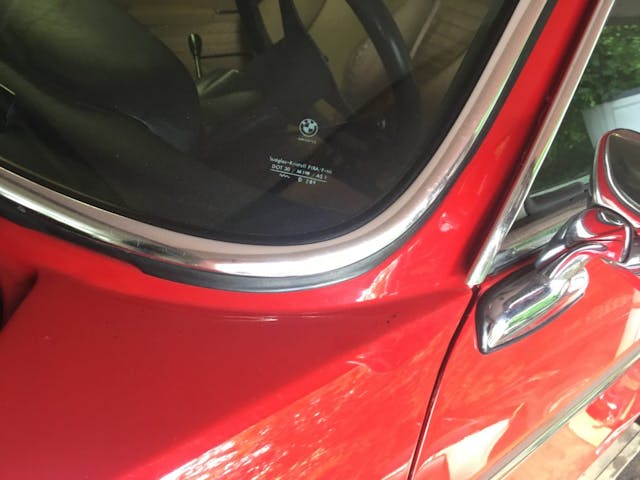
I decided to break the project into two steps. I bought a new nose and fenders ($1400), then paid a shop to cut the old ones off and weld the new ones on ($2300, which included a new OEM windshield to replace the one that cracked during installation). While the fenders were off, the shop repaired a single quarter-sized rust hole underneath. I then drove the car that way for a year while I saved money to get it painted.
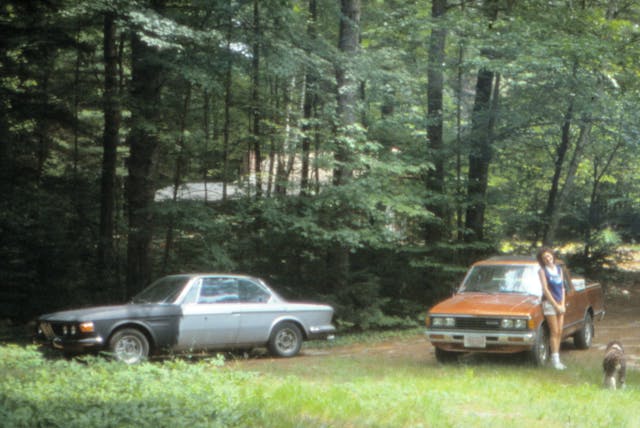
However, as the clock ticked toward 1988 and Maire Anne was pregnant with our first child, the idea of dropping thousands of dollars to get an enthusiast car painted was insane. I marvel that I did it anyway. I found a shop that was active in the local BMW community and whose owner, coincidentally, was redoing an E9. He quoted me $4000 to pull the glass, take the body down to metal, level the panels, and shoot it with seven coats of color and seven coats of clear, all wet-sanded. You can look at the photos below and recoil at the use of body filler, the amount of overspray, and the fact that the engine wasn’t removed when the engine compartment was painted, but please spare me the “do it once, do it right” lecture. Those three things made it affordable—a $4000 paint job and not a $15,000 paint job. Plus, I still didn’t have all the money needed for the paint job, so I took out an unsecured bank loan for $4000. The method to this additional layer of madness was that I expected that Maire Anne and I would be looking for a house in the next few years, and this would help me to build credit.

I was never really bowled over by the car’s Polaris paint, and with the body stripped, I had the opportunity to change it. I saw a new Signal Red Mercedes 560SL and absolutely loved the color, which is a bit richer and deeper than Verona (BMW’s red in the early 1970s). Remember—these cars weren’t worth the six figures they potentially are these days, and people didn’t bat an eyelash about color-changing them with colors outside the manufacturer’s palette. So Signal Red it was.
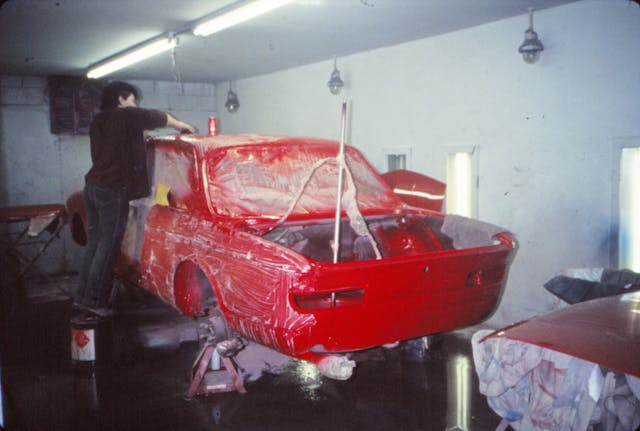
As the shop began reassembling the car, it was quickly obvious that any old trim was going to stick out like a sore thumb against the new paint, so I ponied up for any chrome and rubber that wasn’t part of the original haul from the previous owner’s garage.

The just-painted car was absolutely stunning. The story I often tell is that, shortly after getting the car back, I was at a stop light in Boston when a guy in a new Porsche Carrera pulled up next to me.
“Gorgeous car!” he said.
“Thanks,” I replied with a smile.
Then the other shoe dropped. Remember that I was 29 years old and looked like a young skinny Jerry Garcia. “How does a guy like you afford a car like that?”
“Drugs,” I said, and drove off.
This was the summer of 1988. New baby and a freshly-painted E9 coupe … I really was living the dream. In terms of the car’s outer-body restoration, that was pretty much it; no other paint or bodywork has been performed since on the car. The total sunk cost at the time came to about $13,700. I rationalized that, since it was about the value of the car, I did pretty well, but against the backdrop of a young family, it was bordering on reckless financial endangerment. In hindsight, it’s astonishing that I pulled it off. In terms of the bulk of spending, that was pretty much it. But in terms of the “rolling restoration,” it was just the beginning. Fortunately, the rest of the work I could do myself.
A few months after the car was painted, I (incredibly) stumbled into another rust-free E9 coupe—a white car with a tan leather interior and working air conditioning. It was so well-priced that I couldn’t not buy it. Due to the working A/C, I thought about keeping it and selling the red one, but instead I swapped interiors and sold the white car for a good profit, so I actually made money on the interior swap. The beige leather against the new red paint made me swoon. I completed the interior with a new rug.

My red/beige E9 was now stunning, but the drivetrain felt tired, and the car was a bit of a rattle bucket. It turned out that the guy who painted it was very talented with a spray gun, but did a poor job reassembling the car. I spent decades tracking down rattles, many of which were due to improperly-attached trim, as well as under-hood and interior components.
In late 1988, I happened into a low-mileage engine from a 1984 BMW 533i for a song, as well as a five-speed gearbox. So I dropped in the replacement drivetrain, laughing at the irony that now I was pulling the engine instead of doing it before the engine compartment was painted.

The decades that followed brought installation of air conditioning, an L-Jetronic fuel injection retrofit, suspension upgrades, and a set of Alpina 16-inch open-lug wheels, but the car didn’t really see much road time. All that changed dramatically in 2010 when I began road-tripping the car to what was then called “Vintage at the Vineyard” in Winston-Salem, later changed to “The Vintage” in Asheville, North Carolina.

But in 2014, during the drive down to The Vintage, I hit 500 miles of drenching unrelenting rain, exposing the car to more moisture than it should receive in an entire lifetime. During the bumper-to-bumper rainy traffic on that same trip, a clevis pin and chain flew off the back of a semi and embedded itself in the E9’s front grille. The combination of these things made me shy about road trips unless I could see a clear end-to-end forecast, which of course you can’t if the trip is more than a few hundred miles. The car saw little road time for the next six years. I eventually relaxed, and last year drove the car back to The Vintage.
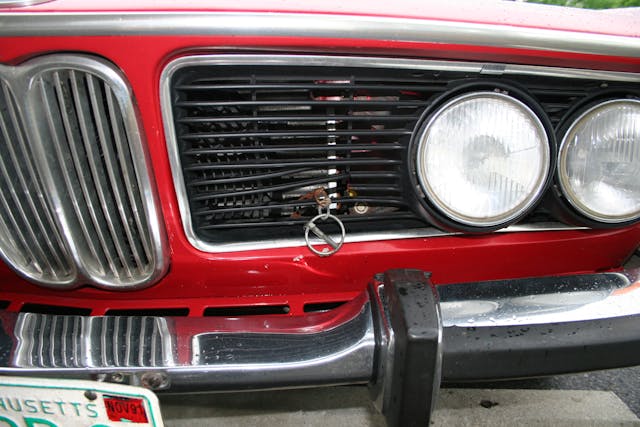
There are many angles from which one can analyze my 37-year-ownership experience of the E9. Jay Leno has famously said that he likes to take cars in rough shape and restore them to 100-point cars, then drive them back down to five-point cars before restoring them again. If I had Jay’s money, maybe I’d do that, but especially with today’s restoration costs, that will never be a play I can make. So I’m careful with the car.
The whole originality-and-correctness thing is its own topic. Judging by Hagerty values and the sales on Bring a Trailer, a photo of this car would sway you into thinking it’s a $100,000–$140,000 E9. But if I ever sold it, purists would rip it apart for the color change, the selection of a non-BMW color, the non-numbers-matching engine, and the swapped interior (the seat and door card pleating changed in 1974, so technically it’s wrong for a ’73). I did the engine, fuel injection, and A/C retrofits myself, and while they look OK to me, it’s telling that, 35 years ago, my column was named “The Hack Mechanic” and not “The Anal-Retentive Correct At Any Cost Mechanic,” so there are nits to be picked there.
One could, if one really wanted to, even argue about the use of base-coat/clear-coat paint. There’s an argument that the shine of base coat/clear coat is just a parlor trick, that classic cars that were original shot with single-stage paint should be repainted that way, and that wet-sandedsingle-stage paint produces a depth of finish that base coat/clear coat can’t match.
What I will say is that, when I bring the car to events ranging from informal cars and coffees to BMW gatherings, when the car is in direct sunlight, and the base-coat/clear-coat finish lights up as if it’s illuminated from underneath, no one has ever said, “Gee, it’s really a shame that you changed the color and butchered the car” or “a straight color would be prettier.” Instead, the response is simply “wow.”
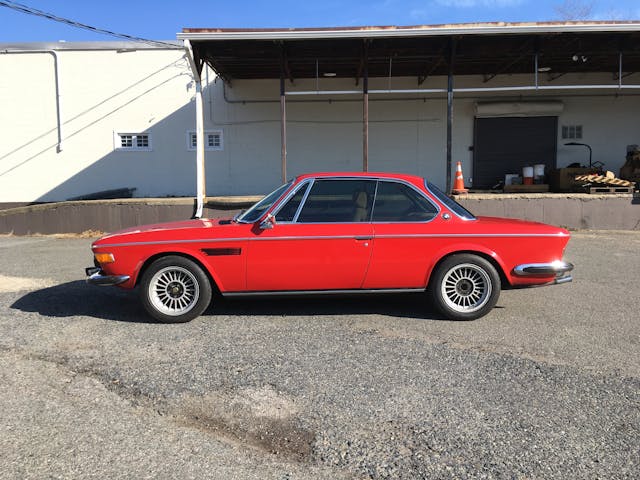
Over the years, I’ve become an avid promoter of living with patina as a much easier (and waaaay less expensive) way to go through automotive life. And I’ve become critical of restoration, saying that the term encompasses such a broad range of actions that it’s become almost meaningless. Most people who say, “I’m restoring such and such” either don’t have a clue of how expensive it’s going to be or have way more money than I do (not that there’s anything wrong with that). Restoration is a fool’s game, and that if you want a pretty shiny car you should buy a pretty shiny car instead of trying to make a silk purse out of a sow’s ear. The E9 is the only car on which I’ve ever had anything remotely akin to an outer-body restoration done, and it’s difficult for me to imagine ever embarking on another one, as the numbers don’t even come close to adding up.
Having said that, it was possibly the best $13,700 I’ve ever spent. I would never have the life-long relationship I have with the car had I left it Polaris/Navy. I wouldn’t love it the way I do. It would’ve vanished long ago in the tidal churn of cars coming and going. Anyone who says, “Gee, it’s a shame you didn’t do it right” or draws conclusion that “The increased value of the car now would completely outpace what it would’ve cost you in 1988 to do it right then” completely misses the point: That never would have happened. It’s really an automotive miracle that the needle got threaded and I’ve had this gorgeous thing to enjoy for the last 35 years.
I hope you love a car as much as I love this one.
“Is that supposed to be worth something?” More than you can possibly imagine.
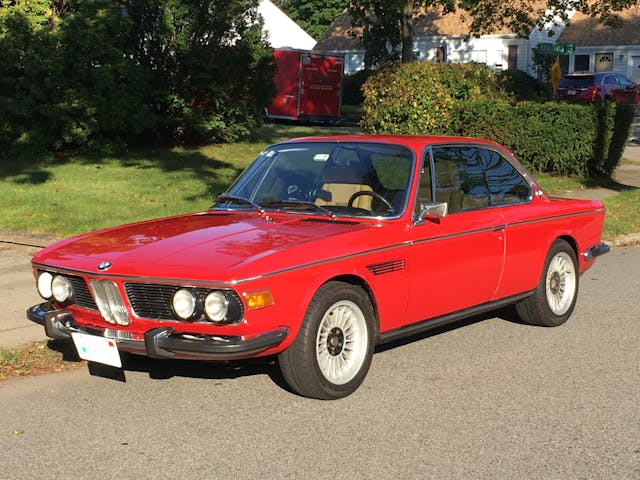
***
Rob’s latest book, The Best of The Hack Mechanic™: 35 years of hacks, kluges, and assorted automotive mayhem is available on Amazon here. His other seven books are available here on Amazon, or you can order personally inscribed copies from Rob’s website, www.robsiegel.com.
Check out the Hagerty Media homepage so you don’t miss a single story, or better yet, bookmark it. To get our best stories delivered right to your inbox, subscribe to our newsletters.

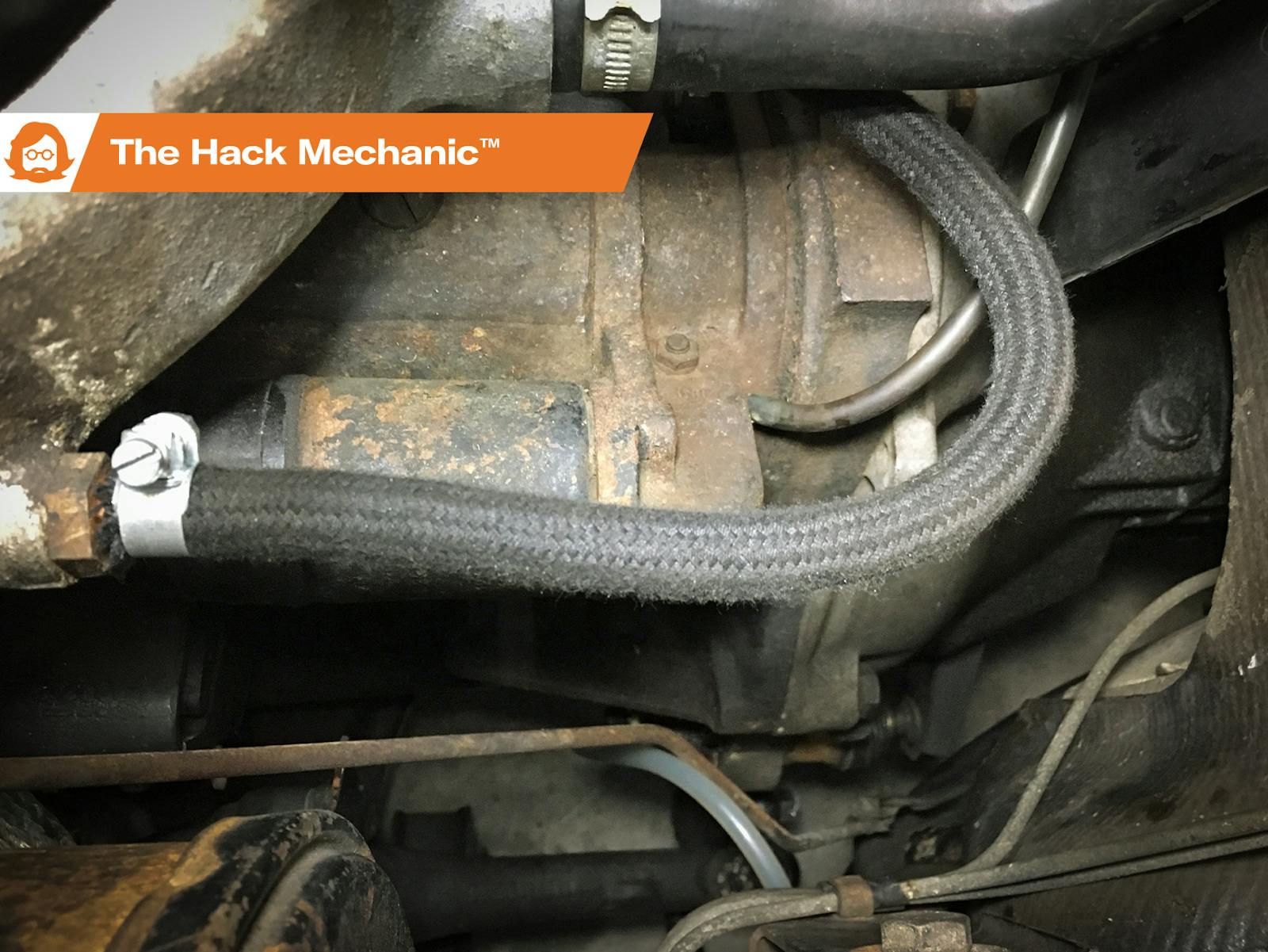
Rob, loved your story. We would never confuse you with Mark Worman, you have more hair and do look more like Waylon Jennings then Mark, however we are glad to see that you have at least one car that does not look like it is held together with bailing wire and duck tape. So what if you do not use date coded wires and hoses, and correctly color coded electrical connections. You should just be glad you have a car you can drive 100 miles with out having a support vehicle following behind to make emergency road side repairs. As Laure on the Cape likes to say, drive it like you stole it,,,,,
Great story, Rob. I too am an advocate for allowing cars to age naturally, and I find those who criticize modifications I’ve made to my cars as “not correct” tiresome. My motto is “Built for me, not for thee.”
“Built for me, not for thee.” I’m totally stealing that. Thanks!
Excellent!
I agree, It’s my car and I’ll make it like I want it!
Great story, Rob. This is why I will always come back to read your articles. You just “get it”. The other day I read an article (on another website) titled “you can’t make your car perfect, and you won’t keep it forever.” Obviously that author just doesn’t get it.
I’ll be the one to say it:
It’s possible down the road the next owner of this car restores it to stock. It’s a special enough thing, with market value to see that happening even if it is an overspend that loses money on the auction to the benefit of the following owner(s).
But maybe it is just enough of a project/modified to deter that. It also has something else:
pedigree in the community.
I think down the line there will be at least a few people that would value it being Siegel’s car done Siegel’s way with decades of documentation and media exposure to back that up. Far cooler in my view.
Snailish, check in next week when I write about the whole subject of the numbers-matching engine :^)
What a beautiful car! You done good.
Rob,
I too have a less than perfect E9 that we LOVE to drive. We were looking for a CLASSIC car to purchase to run in the classic car rallies here on the west coast; we started rallying with the local Alfa club (in our Nissan Altima hybrid), had worked several classics & thought we were ready to run with the big boys & girls. Looked at several different cars, settled on a 2002 (relatively cheap, plentiful & tall enough for my wife & I), but in our search I stumbled across a 1970 2800CS that had the interior removed, paint & body done by the PO’s friend, & a seized engine. Lots has been done to it since then, thankfully I met SF Don (a west coast E9 expert) & had him install a rebuilt M30B34 w/ Motronic FI, Getrag 265 5 speed, vented disc brakes, etc.
Every time I drive the car I love it more! We take it in road trips (it IS a Grand Tourer), run it in rallys & generally LOVE the car. lewisandclarkclassicrally.org nwclassicmotorrally.org alfaclub.org
Also love your articles & books, keep ’em coming!
“Karmann invented rust, then licensed the process to the Italians”…who then gave the process to the Brits as war reparations…and from there the licensing went to Japan to infest their 60s-90s pickup trucks.
Great story!
Always wanted one of these and they have always raced ahead in value so that it is not likely to happen.
“How does a guy like you afford a car like that?” “Drugs,” I said, and drove off.
That line sounds so much like sarcastic me I laughed. I would totally say that.
Rob,
When I joined the BMW CCA in ’77, I started hearing about you. I’ve been following you ever since. Talked with you many times at the Vintage and have always enjoyed you and your stories.
The Coupe is perfect in every way! I love the 100 point cars that others have built and appreciate their sense if accomplishment. On the other hand, fear of driving their cars makes them more a piece of art than anything else. I like that you (and I) can drive our less than 100 point cars (mine is a E39 530i Sport). It may not be 100 points, but it’s mine to drive as I like and not be afraid!
Rob’s articles are the best!
Love the story, and the result.
Just one small thing; a car only has a single windshield. “Front windshield” ranks right there with “totally destroyed.”
Keep up the well-considered work!
I love it and wouldn’t change a thing. Great story, Rob.
Rob, nice story and beautiful car, Love the shape of the E9, You better keep thanking your wife every anniversary after spending 4k on a paint job while expecting your first child ! She’s a keeper, oh and the car is too.
She is that, and more.
Since seeing my first, I have always loved this car – and lusted for one. There is a dentist who has an office in the local mall. He drives it occasionally. You are one lucky dude.